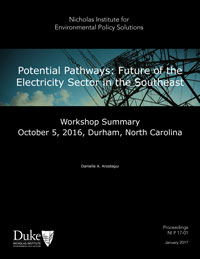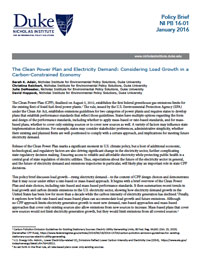Publications
The Future of the Electricity Industry: Implications of Trends and Taxes
This analysis published in the journal Energy Economics examines how changes in market trends and technology costs are likely to affect electricity generation in the United States in the context of possible future carbon taxes. It uses the Dynamic Integrated Economy/Energy/Emissions Model (DIEM) electricity-sector model to examine a wide range of sensitivity cases for technology and fuel costs under different economic conditions. The model finds that carbon taxes can be an effective way to quickly lower emissions. Shifts among natural gas and renewable generation can vary significantly, depending on capital and operating costs.
Understanding the Interaction between Regional Electricity Markets and State Policies
Regional electricity markets—operated by regional transmission organizations (RTOs)—span multiple states and bring significant benefits to the electricity grid. States policies—such as renewable or clean energy portfolio standards or procurement mandates—have always helped shape market outcomes, but increasingly they are aimed at addressing perceived market shortcomings. Recent state policy actions to support new or existing resources in RTO markets have renewed attention to issues of RTO market design, including how RTO markets and state policies interact. Those actions, a rapidly changing electricity sector, and low electricity and capacity prices have heightened the urgency of calls for changes in market designs to address perceived inequities, such as market designs that fail to value certain environmental or reliability attributes. This primer is aimed at policy makers and stakeholders who seek an understanding of regional electricity markets and the effect of state policies on those markets as well as an understanding of recent market design proposals that are designed to address the RTO-state policies interaction.
Potential Pathways: Future of the Electricity Sector in the Southeast—Workshop Summary, October 5, 2016, Durham, North Carolina
The electricity sector is rapidly changing due to the shale gas revolution, a precipitous decline in coal generation, steep declines in the cost of solar generation, the proliferation of smart grid technologies, and a suite of new environmental regulations. On October 5, 2016, Duke University’s Nicholas Institute for Environmental Policy Solutions and the Duke University Energy Initiative co-hosted a one-day workshop that brought together experts on the electricity sector in the Southeast—including representatives of electric utilities, other market participants, nonprofit organizations, and energy and environmental agencies—to discuss factors affecting the region’s electricity sector. The main topics were future demand uncertainty, the ways that technology innovation could affect business models and regulatory structures, and the role of nuclear energy in the Southeast’s electricity future. This proceedings describes the main ideas that emerged from the workshop. It concludes with issues ripe for future research.
The Uncertain Future of Nuclear Power in the Southeast: Implications of an Aging Fleet for Electricity Sector Planning and Emissions
Nuclear power provides about one-quarter of the electricity in the Southeast and the majority of the region’s non-fossil generation. Beginning around 2030, nuclear plants in the Southeast, as in the rest of the country, will start to reach the end of their initial operating license extensions. How many nuclear units will seek and receive a second license extension is unknown. Replacing existing nuclear capacity with new nuclear capacity requires approximately 10 to 15 years. If a high percentage of nuclear units in the Southeast do retire, it is unlikely that they can simultaneously be replaced with new units, given the long lead times and limited applications for new nuclear plants at the Nuclear Regulatory Commission. This policy brief explores how the potential loss of existing nuclear power plants in the Southeast interacts with the region’s other electricity sector challenges and it proposes steps states can take to address these challenges.
North Carolina Electricity Planning
The electricity system is facing new pressures from a changing generation mix, new technologies, consumer demand, and evolving utility business models. Planning for these changes will require participants in the process—utilities, regulators, consumers, and other stakeholders—not only to engage with these coming shifts but also to think critically and collectively about ways to address them. North Carolina has a range of options to institute comprehensive electricity planning that is aligned with effective planning principles and that builds on its past successes.
The Clean Power Plan and Electricity Demand: Considering Load Growth in a Carbon-Constrained Economy
Release of the Clean Power Plan (CPP) marks a significant moment in U.S. climate policy, but a host of economic, technological, and regulatory factors are also driving significant change in the electricity sector, complicating state regulatory decision making. Ensuring access to reliable and affordable electricity while protecting public health is a central goal of state regulation of electric utilities. Thus, expectations about the future of the electricity sector in general, and the future of electricity demand and emissions trajectories in particular, will likely play an important role in state CPP decisions. This policy brief discusses load growth—rising electricity demand—in the context of CPP design choices and demonstrates that it may occur under either a rate-based or mass-based approach. Following a brief overview of the Clean Power Plan and state choices, including rate-based and mass-based performance standards, it summarizes recent trends in load growth and carbon dioxide emissions in the U.S. electricity sector, showing how electricity demand growth in the United States has been low for more than a decade while the carbon intensity of electricity generation has declined. It then explores how both rate-based and mass-based plans can accommodate load growth and future emissions. Although no CPP approach limits electricity generation growth to meet new demand, rate-based approaches and mass-based approaches that cover only existing sources also allow emissions from new sources to increase. Mass-based plans that cover new sources would not limit electricity generation growth, but they would limit emissions from all covered sources.
The EPA’s Clean Power Plan: Understanding and Evaluating the Proposed Federal Plan and Model Rules
On August 3, 2015, the U.S. Environmental Protection Agency (EPA) finalized carbon dioxide (CO2) emission guidelines for two categories of existing power plants under section 111(d) of the Clean Air Act. The final rule, referred to as the Clean Power Plan, requires each state to develop its own plan that applies equivalent standards of performance to affected units. If a state fails to submit an adequate plan, the Clean Air Act authorizes the EPA to develop and implement a federal plan for the state. In a separate action, the EPA proposed mass- and rate-based versions of a federal plan as well as mass- and rate-based model rules, which states could choose to adopt or to adapt by substituting their own provisions subject to EPA approval. The proposed model rules are similar to but more flexible than the federal plan proposals. This policy brief summarizes the final Clean Power Plan rule, describes the mass- and rate-based proposed federal plans, identifies areas in which the model rules differ, highlights key issues for states and other stakeholders as they evaluate the tradeoffs among plan pathways, and discusses the EPA’s timeline for finalizing the federal plan and model rules.
Assessing Impacts of the Clean Power Plan on Southeast States
The proposed Clean Power Plan gives U.S. states flexibility in how they attain state-level carbon dioxide emissions rate goals from existing power plants. This analysis explores the potential impact of the proposed CPP on Southeast states across a range of compliance options relative to a baseline without the CPP. The analysis presents modeling results from the Dynamic Integrated Economy/Energy/Emissions Model for eight primary compliance scenarios involving rate-based or mass-based compliance, unilateral state action or regional cooperation, and inclusion or non-inclusion of natural gas combined cycle (NGCC) units as regulated entities under the CPP.
Regarding electricity sector adjustments, the modeling shows that a rate-based approach initially decreases coal generation, encourages use of existing and construction of new NGCC units, and incentivizes renewable generation, although use of renewables is not cost-effective in the Southeast under baseline cost assumptions. By comparison, a mass-based approach initially increases coal generation and removes incentives for use of existing NGCC units while significantly increasing new NGCC generation. Including new NGCC units under CPP compliance shifts generation from those units to existing NGCC units under mass-based compliance and increases coal generation under rate-based compliance.
Regarding policy costs, the modeling shows that individual state compliance costs vary considerably, that a mass-based approach initially entails half the costs of a rate-based approach, and that both regional rate-based and mass-based approaches create significant net cost savings over unilateral state compliance.
Enhancing Compliance Flexibility under the Clean Power Plan: A Common Elements Approach to Capturing Low-Cost Emissions Reductions
As states and stakeholders evaluate compliance options under the U.S. Environmental Protection Agency’s proposed Clean Power Plan, many recognize the potential economic benefits of market-based strategies. In some states, however, market approaches trigger administrative and political hurdles. A new policy brief by the Nicholas Institute for Environmental Policy Solutions offers a compliance pathway that allows states to realize the advantages of multistate and market-based solutions without mandating either strategy. With the common elements approach, states develop individual-state plans to achieve their unique emissions targets and give power plant owners the option to participate in cross-state emissions markets. Power plant owners can transfer low-cost emissions reductions between states whose compliance plans share common elements--credits defined the same way and mechanisms to protect against double counting. The common elements approach offers the following benefits: (1) allows cross-state credit transfers without states negotiating a formal regional trading scheme, (2) leaves compliance choices to power companies, (3) builds on existing state and federal trading programs, and (4) maintains the traditional roles of state energy and environmental regulators.
Author(s): Jonas Monast, Tim Profeta, Jeremy Tarr, and Brian Murray
Completing the Energy Innovation Cycle: The View from the Public Utility Commission
Achieving a widespread adoption of innovative electricity generation technologies involves a complex system of research, development, demonstration, and deployment, with each phase then informing future developments. Despite a number of non-regulatory programs at the federal level to support this process, the innovation premium—the increased cost and technology risk often associated with innovative generation technologies—creates hurdles in the state public utility commission (PUC) process. This article in the Hastings Law Journal examines how and why innovative energy technologies face challenges in the PUC process, focusing on case studies where PUCs have approved or denied utility proposals to deploy high cost, first-generation energy technologies. It concludes with an outline of possible strategies to address PUC concerns by allocating the innovation premium beyond a single utility's ratepayers.










